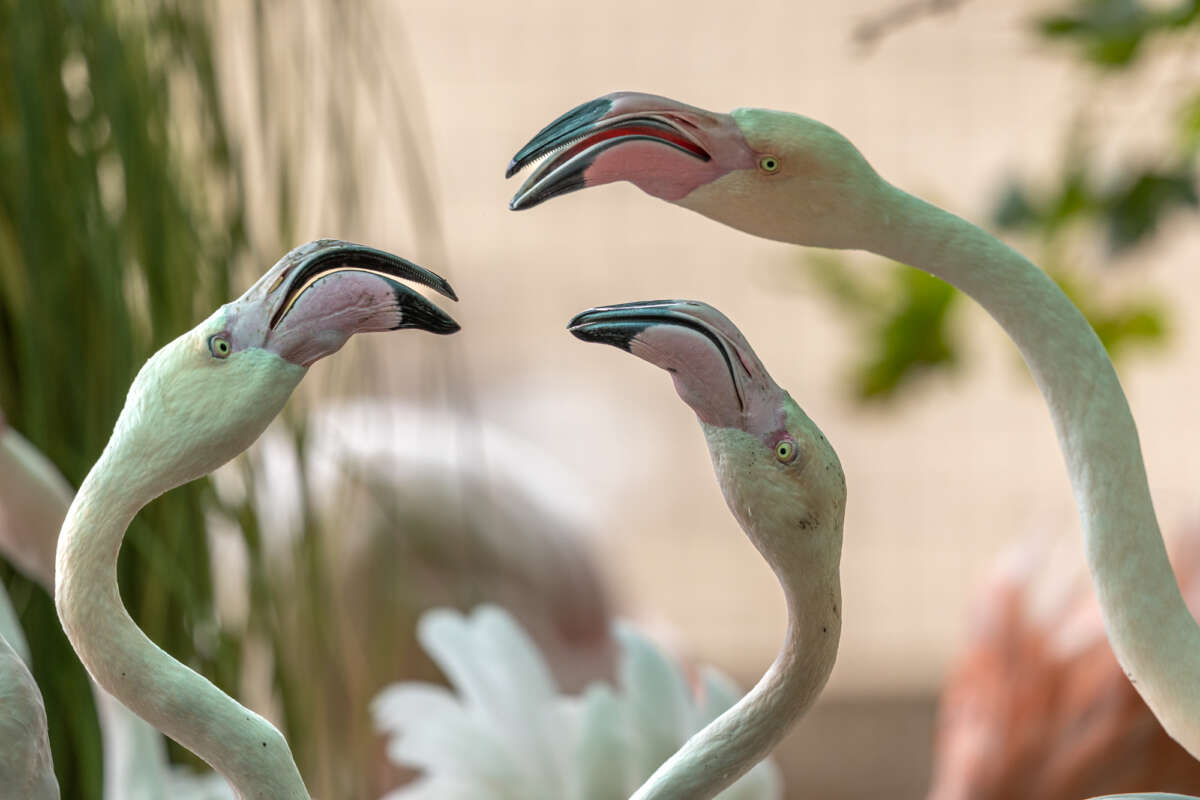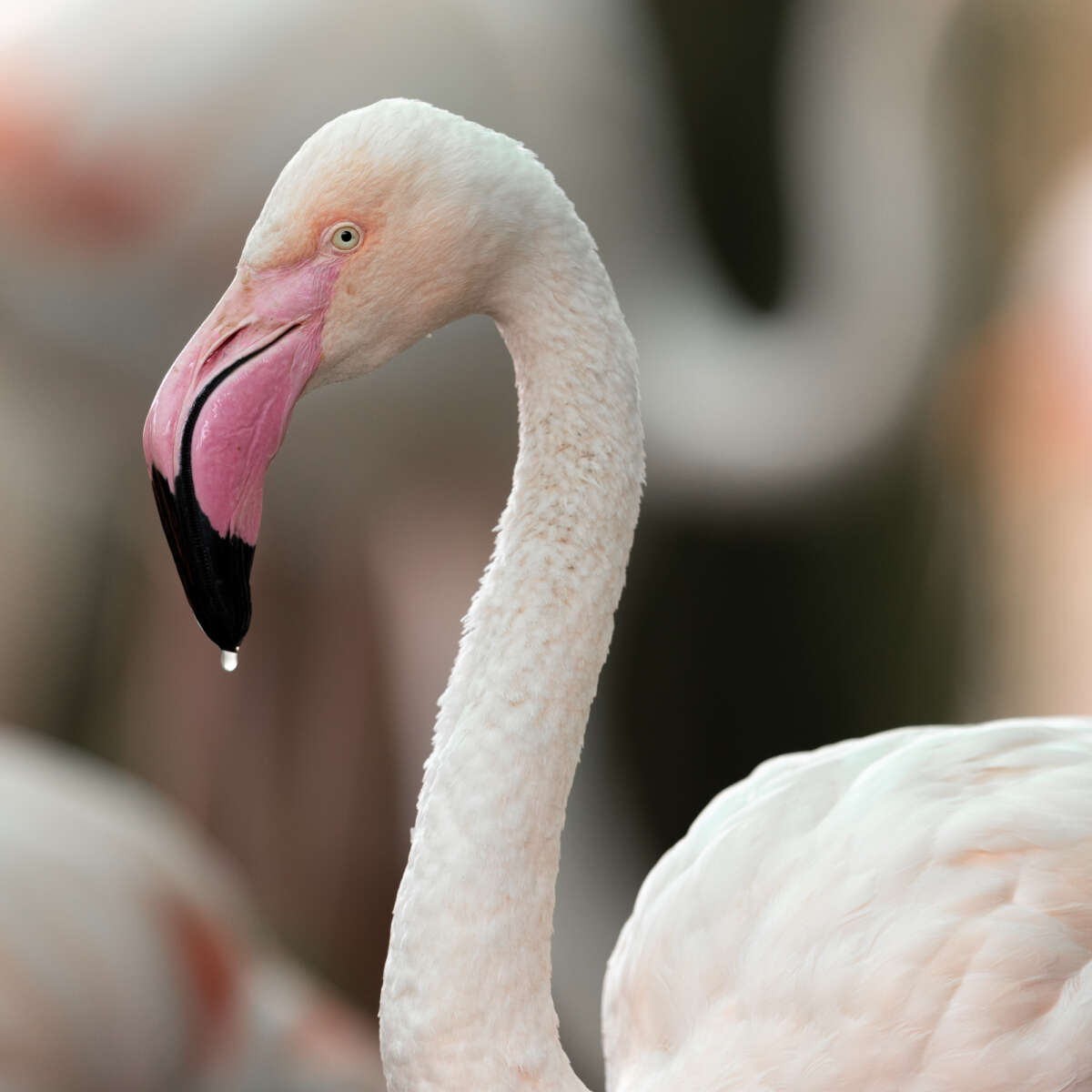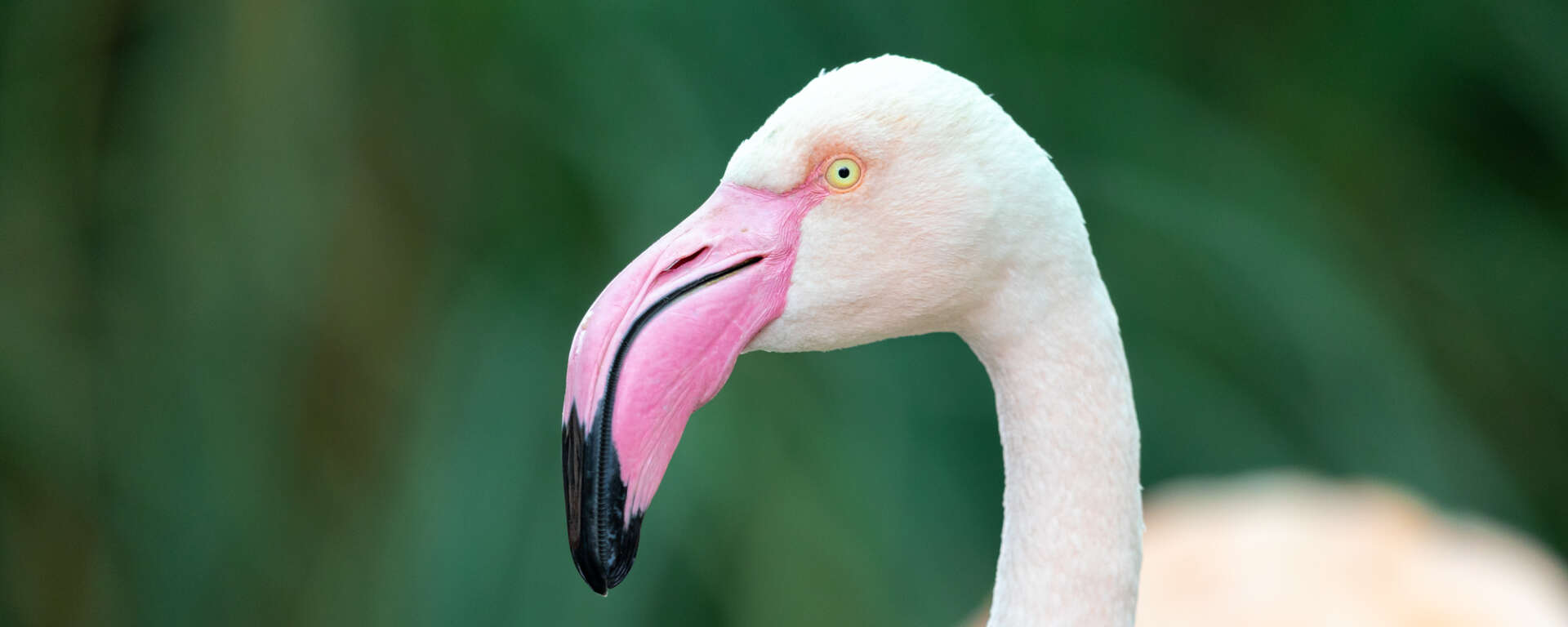Description
Flamingos are unique and unmistakable birds. They have existed in their current form for a long time—fossils of flamingo ancestors that are morphologically similar to the flamingos we see today have been found dating back to ~30 million years ago. Flamingos all have a characteristic oval-shaped body, with an extremely long neck above and extremely long legs below. They have the longest neck and legs relative to their body size of any bird in the world.
All species of flamingo have varying shades of characteristic pink plumage, which comes from carotenoid pigments in their diet. Most of a flamingo’s feathers are this pink color, except for their flight feathers, which are colored by melanin pigment and are black. It is thought that feathers pigmented by melanin are slightly more resistant to wear, and flamingos benefit from these more robust flight feathers during their migrations. Even if fed the same food under human care, different species of flamingo will still be different shades of pink from each other, suggesting that the different species have variation in their physiological mechanisms of processing and expressing these pigments. Juvenile flamingos are gray, slowly growing in pinker feathers as they consume more carotenoid pigments. It takes 2 – 4 years for flamingos to reach full adult plumage. Flamingo legs are also affected by these pigments—juveniles have black legs that slowly turn pink over the first few years of their lives.
Another unique aspect of flamingos is their beaks, which allows them to feed in a way similar to baleen whales. The inner edges of their beak are lined with hair-like structures called lamellae that can raised and lowered at will. Inside of the flamingo’s beak is a tongue that acts as a piston, sucking in and expelling water as it moves forward and back. A flamingo will lower the lamellae and move its tongue back, sucking particulate-filled water into its mouth. It will then raise the lamellae and move its tongue forward, pushing the water out while the raised lamellae act as a filter, collecting any food particles in the water, which are then swallowed. The 45 degree angle in the middle of their beak allows flamingos to have the gap between their upper and lower mandible be about the same throughout the entire length of their beak when they open their mouth, significantly increasing the effectiveness of their filter feeding.
Flamingos are often seen resting while standing on one leg, with the other leg tucked into their body feathers. This likely serves a thermoregulatory function, reducing the heat lost through extremely long, thin legs. However, flamingos are often seen in this position on hot days, so it is also likely just a comfortable resting position.
The greater flamingo, along with the American flamingo, are the two largest flamingo species in the world. The greater flamingo has the most pale whiteish-pink plumage of any flamingo species.
Cover Photo: Adult greater flamingo by Mark Pressler
Classification
- Overview
- Flamingos are the only members of the order Phoenicopteriformes. There are six species of flamingo. The greater flamingo and American flamingo were previously thought to be the same species, but now most taxonomists recognize them as separate species.
- Class
- Aves
- Order
- Phoenicopteriformes
- Family
- Phoenicopteridae
- Genus
- Phoenicopterus
- Species
- P. roseus
Key Facts
- Conservation Status
- Least Concern
- Lifespan
- ~33 years in the wild, up to 60 years under human care. Oldest recorded individual under human care was 83 years old.
- Height
- 3.94 – 4.76 ft (120 – 145 cm)
- Weight
- 4.6 – 9.0 lbs (2.1 – 4.1 kg)
- Wingspan
- 4.60 – 5.41 ft (140 – 165 cm)
The IUCN Red list describes the greater flamingo as a species of Least Concern, meaning conservationists around the world are not currently worried about the continuation of this species. A study published in 2015 estimated the number of greater flamingos at between 550,000 – 680,000 individuals. The population is currently increasing.
Social Life
Flamingos are extremely social birds. A group of flamingos is known as a “flamboyance.” Greater flamingos are sometimes found in flocks of up to 400,000 individuals in India!
Starting a few months before breeding and continuing after, flamingos engage in collective displays with each other. In greater flamingos, these sometimes consist of hundreds of birds displaying at once. The purpose of these displays seems to be to stimulate hormones and synchronize breeding and nesting as much as possible, to take advantage of optimal habitat conditions for raising young and the relative safety of nesting at the same time as many other birds. These displays consist of a series of “dance moves”, which include:
- Marching in unison in a tightly packed group
- “Head flagging”: stretching the neck upwards with the beak pointing up, and rhythmically moving the head back and forth
- “Wing salute”: spreading their wings wide open for a few seconds with their necks outstretched
- “Twist-preen”: twisting their neck back to appear as if they are cleaning the feathers on their back for a few seconds, before popping their heads back up
- “Wing-leg stretch”: extending the wing and leg on the same side of their body out backwards
Sometimes these “dance moves” are seen in a predictable sequence, with “head flagging” into “wing salute” into “twist-preen” being one of the most common routines.
When flamingo chicks hatch, they are quickly able to stand and walk around, and will join up with the other chicks in the breeding colony in a sort of group daycare situation known as a “creche”. These chicks will be looked after by a few adults while most adults go feed, and can consist of hundreds or even thousands of chicks.
Habitat and Range
Greater flamingos are found around saline lagoons and salt pans, as well as in large, shallow, highly alkaline or saline lakes. They are extremely widespread, seen in coastal areas of Africa, southern Europe, and Asia, as well as the lakes of the great rift valley in eastern Africa.
Flamingos are not considered “true” migratory birds in that they do not consistently move between the same relative locations. Some species do migrate, but it is inconsistent and erratic. For example, in Southern France, greater flamingos will migrate either south-west to Spain and Morocco, or south-east to Sardinia, Tunisia, Algeria, and even Turkey, depending on the direction of the prevailing winds in the fall of their hatch year. Migration or dispersal to more favorable habitat happens based on breeding, food availability, temperature, and other environmental cues. Some populations seem to be fairly sedentary when habitat conditions are more consistently favorable. Flocks of hundreds of flamingos have been observed flying up to ~350 miles (500 – 600 km) in a single night.
Diet
Flamingos are filter feeders, eating algae, small crustaceans, mollusks, insects, small fish and the seeds of some plants. They will also tread in the mud to stir up more food. For feeding mechanisms and the effects of diet on flamingo pigmentation, see Description in the Information tab.
Flamingos will both feed from the substrate at the bottom of deeper water with their head and most of their neck underwater, and feed from the surface of shallower water by sweeping their neck and head back and forth. In areas where greater flamingos and lesser flamingos are both present, greater flamingos tend to feed on invertebrates at the bottom of the water body, while lesser flamingoes tend to feed on algae close to the surface of the water. This is known as “niche partitioning”, and greatly reduces competition between the two species.
Because flamingo chick beaks are not developed enough to filter feed at birth, flamingo parents (both male and female) will produce a liquid in their upper digestive tract known as “crop milk”. This secretion, which has similar nutritional value to mammal milk, is dripped directly into the chick’s mouth. Under human care, non-parents have also been observed producing crop milk and feeding it to chicks.
Predators
Flamingos tend to live in fairly inhospitable habitats, which sometimes only support flamingos and the microorganisms they feed on. Because of this, predation risk is lower than for species that live in constant close contact with predators. However, hyenas, lions, leopards, cheetahs, and jackals have all been observed preying on flamingos. Predatory birds will prey on young flamingos, and large predators like marabou storks or hyenas can cause large disruptions if they gain access to nesting areas, sometimes causing thousands of flamingos to abandon their nests.
Reproduction
Sexual Maturity: 5-6 years, although can be as early as 3 or 4
Breeding & Nesting Season: Highly variable depending on location. Feb – May around the Mediterranean.
Incubation: 27 – 31 days
Clutch Size: 1, rarely 2 eggs
- Information
-
Description
Flamingos are unique and unmistakable birds. They have existed in their current form for a long time—fossils of flamingo ancestors that are morphologically similar to the flamingos we see today have been found dating back to ~30 million years ago. Flamingos all have a characteristic oval-shaped body, with an extremely long neck above and extremely long legs below. They have the longest neck and legs relative to their body size of any bird in the world.
All species of flamingo have varying shades of characteristic pink plumage, which comes from carotenoid pigments in their diet. Most of a flamingo’s feathers are this pink color, except for their flight feathers, which are colored by melanin pigment and are black. It is thought that feathers pigmented by melanin are slightly more resistant to wear, and flamingos benefit from these more robust flight feathers during their migrations. Even if fed the same food under human care, different species of flamingo will still be different shades of pink from each other, suggesting that the different species have variation in their physiological mechanisms of processing and expressing these pigments. Juvenile flamingos are gray, slowly growing in pinker feathers as they consume more carotenoid pigments. It takes 2 – 4 years for flamingos to reach full adult plumage. Flamingo legs are also affected by these pigments—juveniles have black legs that slowly turn pink over the first few years of their lives.
Another unique aspect of flamingos is their beaks, which allows them to feed in a way similar to baleen whales. The inner edges of their beak are lined with hair-like structures called lamellae that can raised and lowered at will. Inside of the flamingo’s beak is a tongue that acts as a piston, sucking in and expelling water as it moves forward and back. A flamingo will lower the lamellae and move its tongue back, sucking particulate-filled water into its mouth. It will then raise the lamellae and move its tongue forward, pushing the water out while the raised lamellae act as a filter, collecting any food particles in the water, which are then swallowed. The 45 degree angle in the middle of their beak allows flamingos to have the gap between their upper and lower mandible be about the same throughout the entire length of their beak when they open their mouth, significantly increasing the effectiveness of their filter feeding.
Flamingos are often seen resting while standing on one leg, with the other leg tucked into their body feathers. This likely serves a thermoregulatory function, reducing the heat lost through extremely long, thin legs. However, flamingos are often seen in this position on hot days, so it is also likely just a comfortable resting position.
The greater flamingo, along with the American flamingo, are the two largest flamingo species in the world. The greater flamingo has the most pale whiteish-pink plumage of any flamingo species.
Cover Photo: Adult greater flamingo by Mark Pressler
Classification
- Overview
- Flamingos are the only members of the order Phoenicopteriformes. There are six species of flamingo. The greater flamingo and American flamingo were previously thought to be the same species, but now most taxonomists recognize them as separate species.
- Class
- Aves
- Order
- Phoenicopteriformes
- Family
- Phoenicopteridae
- Genus
- Phoenicopterus
- Species
- P. roseus
Key Facts
- Conservation Status
- Least Concern
- Lifespan
- ~33 years in the wild, up to 60 years under human care. Oldest recorded individual under human care was 83 years old.
- Height
- 3.94 – 4.76 ft (120 – 145 cm)
- Weight
- 4.6 – 9.0 lbs (2.1 – 4.1 kg)
- Wingspan
- 4.60 – 5.41 ft (140 – 165 cm)
- Conservation
The IUCN Red list describes the greater flamingo as a species of Least Concern, meaning conservationists around the world are not currently worried about the continuation of this species. A study published in 2015 estimated the number of greater flamingos at between 550,000 – 680,000 individuals. The population is currently increasing.
- Lifestyle
Social Life
Flamingos are extremely social birds. A group of flamingos is known as a “flamboyance.” Greater flamingos are sometimes found in flocks of up to 400,000 individuals in India!Starting a few months before breeding and continuing after, flamingos engage in collective displays with each other. In greater flamingos, these sometimes consist of hundreds of birds displaying at once. The purpose of these displays seems to be to stimulate hormones and synchronize breeding and nesting as much as possible, to take advantage of optimal habitat conditions for raising young and the relative safety of nesting at the same time as many other birds. These displays consist of a series of “dance moves”, which include:
- Marching in unison in a tightly packed group
- “Head flagging”: stretching the neck upwards with the beak pointing up, and rhythmically moving the head back and forth
- “Wing salute”: spreading their wings wide open for a few seconds with their necks outstretched
- “Twist-preen”: twisting their neck back to appear as if they are cleaning the feathers on their back for a few seconds, before popping their heads back up
- “Wing-leg stretch”: extending the wing and leg on the same side of their body out backwards
Sometimes these “dance moves” are seen in a predictable sequence, with “head flagging” into “wing salute” into “twist-preen” being one of the most common routines.
When flamingo chicks hatch, they are quickly able to stand and walk around, and will join up with the other chicks in the breeding colony in a sort of group daycare situation known as a “creche”. These chicks will be looked after by a few adults while most adults go feed, and can consist of hundreds or even thousands of chicks.
Habitat and Range
Greater flamingos are found around saline lagoons and salt pans, as well as in large, shallow, highly alkaline or saline lakes. They are extremely widespread, seen in coastal areas of Africa, southern Europe, and Asia, as well as the lakes of the great rift valley in eastern Africa.Flamingos are not considered “true” migratory birds in that they do not consistently move between the same relative locations. Some species do migrate, but it is inconsistent and erratic. For example, in Southern France, greater flamingos will migrate either south-west to Spain and Morocco, or south-east to Sardinia, Tunisia, Algeria, and even Turkey, depending on the direction of the prevailing winds in the fall of their hatch year. Migration or dispersal to more favorable habitat happens based on breeding, food availability, temperature, and other environmental cues. Some populations seem to be fairly sedentary when habitat conditions are more consistently favorable. Flocks of hundreds of flamingos have been observed flying up to ~350 miles (500 – 600 km) in a single night.
Diet
Flamingos are filter feeders, eating algae, small crustaceans, mollusks, insects, small fish and the seeds of some plants. They will also tread in the mud to stir up more food. For feeding mechanisms and the effects of diet on flamingo pigmentation, see Description in the Information tab.Flamingos will both feed from the substrate at the bottom of deeper water with their head and most of their neck underwater, and feed from the surface of shallower water by sweeping their neck and head back and forth. In areas where greater flamingos and lesser flamingos are both present, greater flamingos tend to feed on invertebrates at the bottom of the water body, while lesser flamingoes tend to feed on algae close to the surface of the water. This is known as “niche partitioning”, and greatly reduces competition between the two species.
Because flamingo chick beaks are not developed enough to filter feed at birth, flamingo parents (both male and female) will produce a liquid in their upper digestive tract known as “crop milk”. This secretion, which has similar nutritional value to mammal milk, is dripped directly into the chick’s mouth. Under human care, non-parents have also been observed producing crop milk and feeding it to chicks.
Predators
Flamingos tend to live in fairly inhospitable habitats, which sometimes only support flamingos and the microorganisms they feed on. Because of this, predation risk is lower than for species that live in constant close contact with predators. However, hyenas, lions, leopards, cheetahs, and jackals have all been observed preying on flamingos. Predatory birds will prey on young flamingos, and large predators like marabou storks or hyenas can cause large disruptions if they gain access to nesting areas, sometimes causing thousands of flamingos to abandon their nests.Reproduction
Sexual Maturity: 5-6 years, although can be as early as 3 or 4
Breeding & Nesting Season: Highly variable depending on location. Feb – May around the Mediterranean.
Incubation: 27 – 31 days
Clutch Size: 1, rarely 2 eggs

Adult greater flamingo conflict resolution by Mark Pressler

Adult greater flamingo by Mark Pressler

